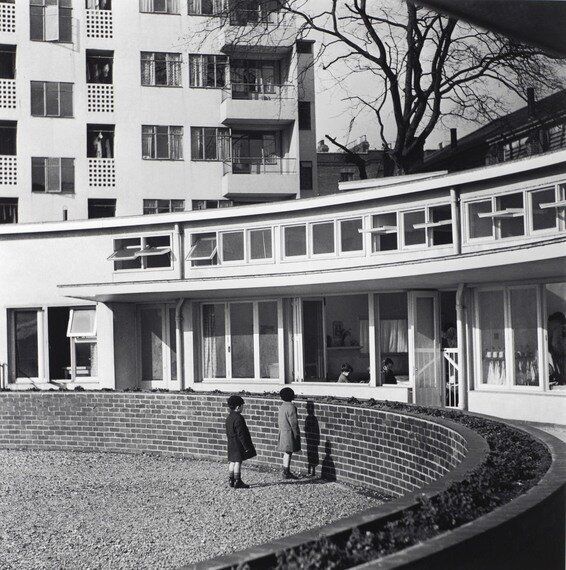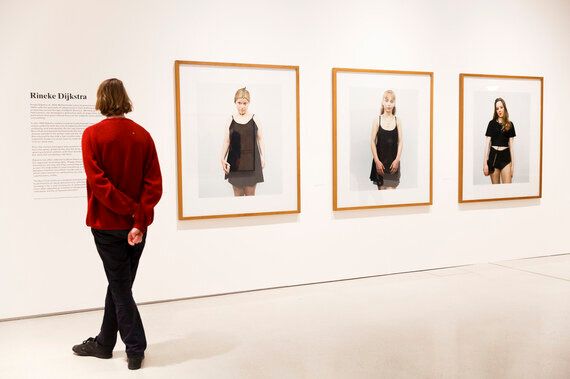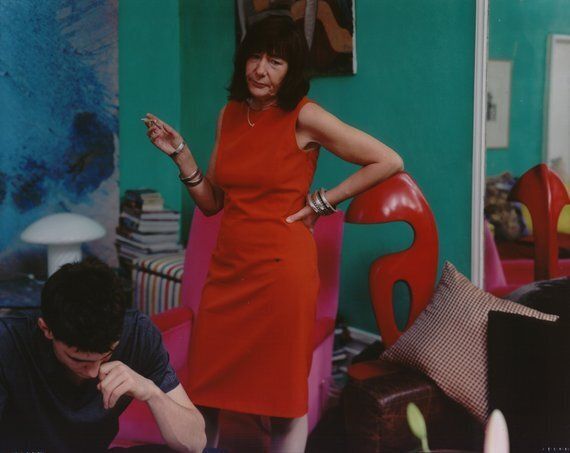This exhibition is about the everyday lives of you and me, our parent's and grandparents. It is a community album, a gift from 23 international photographers, who have been documenting our mundane and celebratory moments since the 1930s.Strange and Familiar, curated by Magnum Photographer Martin Parr, presents a glimpse of our social, political and cultural landscape from an outsider's prospective.
In Parr's words
"The exhibition will reveal a very different take on British life than that produced by British photographers. It is both familiar and strange at the same time."
The recognisable symbols of British life; glass milk bottles on doorsteps, Jubilee street parties, football matches, miners, post-war concrete architecture and the class system, are all there to connect us with our cultural emblems. These photographs talk to our instinctual need to connect with the past, in order to make sense of the present; it is an unflinching account of all things that we look to for cultural comfort and pride, and at times shame.
The exhibition is curated by decade, starting from the voyeuristic black and whites from the 1930's, up to the large and glaringly intimate portraits favoured by some of today's photographers.
Starting in the mid-1930s with Edith Tudor-Hart's images of London's East End to the slum housing areas of Tyneside that capture the child welfare, unemployment and homelessness that characterised the interwar years. Henri Cartier-Bressons images give us the celebratory spirit at the Coronation of King George VI, the work of Gian Butturini and Frank Habicht show the
Swinging Sixties and the anti-War movement.

Edith Tudor-Hart. Kensal House, London ca. 1938 © Edith Tudor-Hart / National Galleries of Scotland
Paul Strand's images feature the lives and landscape of the Scottish Isles of the Outer Hebrides during the 50's, whilst Robert Frank's portrayal of life in London alongside the coal mining towns of South Wales, depict the rise of a British corporate culture and the relationship between wealth and poverty.
The Dutch photographer Cas Oorthuys captured the mid-century street landscape in Cambridge, London and Oxford with all its quirks.
A highlight is Bruce Davidson's work in England and Scotland from 1960, which uncovers the contrasts between city and country life, of the landed gentry and the working class people as he focused his camera on bankers, cleaners, bombed-out buildings, public transport and youths in Soho.
Naturally Garry Winogrand is included, this time with little known portraits of travellers through the UK in 1968. In the same year, the Japanese photojournalist Akihiko Okamura moved to Dublin to cover the conflict in Northern Ireland. His work depicts the everyday experience of barricades, demonstrations, and bombed out streets.

Akihiko Okamura Northern Ireland, 1970s © Akihiko Okamura / Courtesy of the Estate of Akihiko
Okamura, Hakodate, Japan
The 70's start with Gilles Peress who traveled to Northern Ireland nearly every year for two decades to document the conflict.
In 1977, Shinro Ohtake looks to London's inhabitants, whilst Hans Eijkelboom's collection shows images of street shoppers snapped at The Bullring in Birmingham, which are arranged into a complex grid according to similarities: clothing or gestures that question the construction of Identity.
As a child born the 70's, I was drawn to the luminous portraits depicting youth in the early part of this century. With a sense of camaraderie, I enjoyed Rineke Dijkstra's intimate portraits of Liverpool clubbers. Reassuringly familiar, to any teenager who has spent a night in the local nightclub, where bravado and sexual naivety collide. Women will recognise their own innocent and still gazes in those of the clubbers; all photographed delicately with her maternal eye. The accepted idea that local nightclubs are escape from conformity, is turned on it's head with uniform portraits of tribes in Lycra and cheap make-up.

Curated by Martin Parr Installation View Barbican Art Gallery, London 16 February - 19 June 2016
© Tristan Fewings/ Getty Images
Opposing these images of lost youth, literally, were portraits of the seemingly secure, upper classes by Tina Barney. Their melancholic gazes highlight the distance between the 'them' and 'us', a reflection of the class divide. There is a ceremonial lack of intimacy in these portraits, a gap which increases the more one attempts to connect with the subjects. I found my 7 year old daughter standing silently, staring back at these large faces glaring blankly at her, in a stand off of alien cultures.

Tina BarneyThe Red Sheath, 2001© Tina Barney, Courtesy of Paul Kasmin Gallery
It is so interesting visiting an exhibition with a child. Her interest escalated with the scale of the prints. Bruce Gilden's prints were so large, that she had to stand back and look up to them, as a child would to a towering adult. In contrast to Barney's portraits, she felt compelled to stepped in to Gilden's unpolished close-ups of the working classes, asking questions about the features on their faces, and what the subjects felt about having their picture taken. There was an instant humility and connection between subject and viewer, a open exchange, which made Gilden's portraits an anthropological success. The wonky faces mapped with wrinkles, veined cheeks and heavy make up, she felt comfortable getting close to them.

Curated by Martin Parr Installation View Barbican Art Gallery, London 16 February - 19 June 2016
© Tristan Fewings/ Getty Images
Raymond Depardon's images of the residents of the Goven and Manhill estates in Glasgow, captured what at first seems a bleak depiction of childhood. Dark landscapes, illuminated only by the clothes drying on a washing line, a bright pink balloon, or a child's pram full with dolls. I thought about how a child's world is as small as that which the lens falls on. Within that small existence, it is the props of childhood, the toys and games with friends around those very washing lines; that memories make. Who cares, as a child, if your backdrop is filled with bleak factories and wet pavements; the streets are your playground, and Depardon presented back to us the freedom that came with outdoor play in the mid-century, an experience seldom enjoyed by kids today.
Whenever and wherever in Britain you grew up, seeing this exhibition will gift you a family album you've long forgotten.